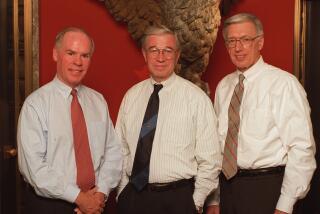Jerome Rubin dies at 86; futurist who foresaw e-books
At a 1989 gathering of publishing giants, Jerome Rubin made an unpopular forecast: Technology would render the book obsolete.
He argued that the expansion of computerized databases would decrease the need for printed books, a pronouncement based on firsthand experience.
In the early 1970s, Rubin helped bring to market both the commercial online research database now known as LexisNexis and the display technology behind the Amazon Kindle and other e-readers.
Rubin died Jan. 9 at New York-Presbyterian/Weill Cornell Medical Center in New York City of a stroke, his children said. He was 86.
Although he was trained as a physicist and attorney, Rubin was hired in 1970 by an Ohio-based company to make commercially viable what was then a novel product: a computer “search and retrieval system” or database of state case law.
He guided development of the Lexis database, initially built in 1973 to run on customized terminals. A few years later it was joined by Nexis, which focused on news, including wire services and newspaper articles.
“We were building something new. It didn’t exist,” said Bob Bennett, who worked with Rubin during the development of LexisNexis. The system was initially designed by lawyers for lawyers, he said.
The database “was the first on any large scale,” Bennett said, “and successful.”
In 1982, Rubin was hired by Times Mirror Co., which then owned the Los Angeles Times, as a vice president of a specialized publishing division. He was made chairman of professional information and book publishing in 1989.
After leaving in 1992, he joined MIT’s Media Laboratory and led a consortium called News in the Future. The job led him to co-found E Ink, a company devoted to developing electronic paper for publishing, in 1997 with Russ Wilcox and others.
“At an age when most men would be relaxing ... Jerry felt nothing could be more fun for him than to start a brand-new company with cutting-edge technology,” Wilcox said. “He saw business as an adventure and he inspired others around him to dream big.”
Jerome Sanford Rubin was born March 9, 1925, in New York City and received a bachelor’s degree in 1944 from Harvard University. He earned a law degree from the school in 1949.
In 1957, he married Ida Ely, who preceded him in death. He is survived by his children, Richard Rubin and Alicia Yamin.
As early as 1994, Rubin envisioned a newspaper put together by readers instead of editors. A smart computer program in the home would print a newspaper tailored to each reader’s interests and needs, he said.
By 2000, he was talking about having an electronic newspaper, “one broadsheet, the size of the New York Times,” on the breakfast table.
“It would look like an ordinary sheet of paper,” he told Harvard magazine. “You’ll turn a little switch at one corner of it as you begin to pour your orange juice and, within a second or two, the front page of the Times — or the Harvard Crimson or whatever you want — will pop up. They are all delivered wireless.”
Linda Gras, Rubin’s assistant from 1984 to 1992, said last week of the futurist: “He could see much further in the distance than pretty much anybody.”
More to Read
Start your day right
Sign up for Essential California for the L.A. Times biggest news, features and recommendations in your inbox six days a week.
You may occasionally receive promotional content from the Los Angeles Times.






